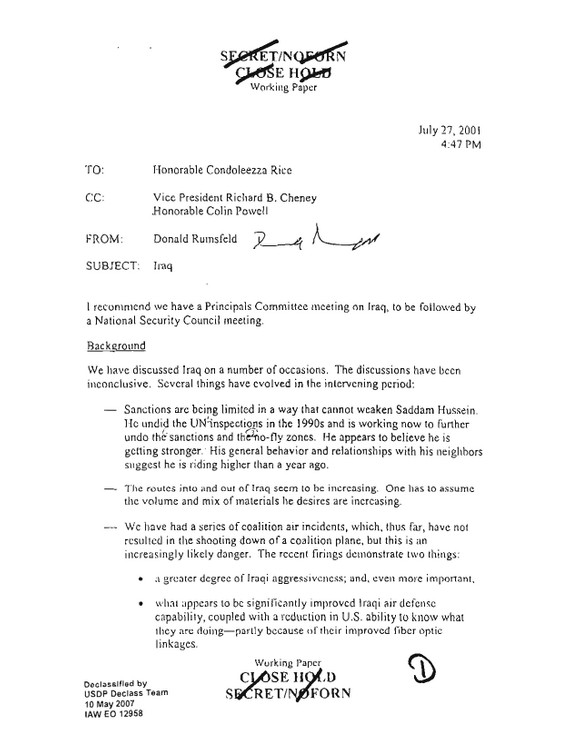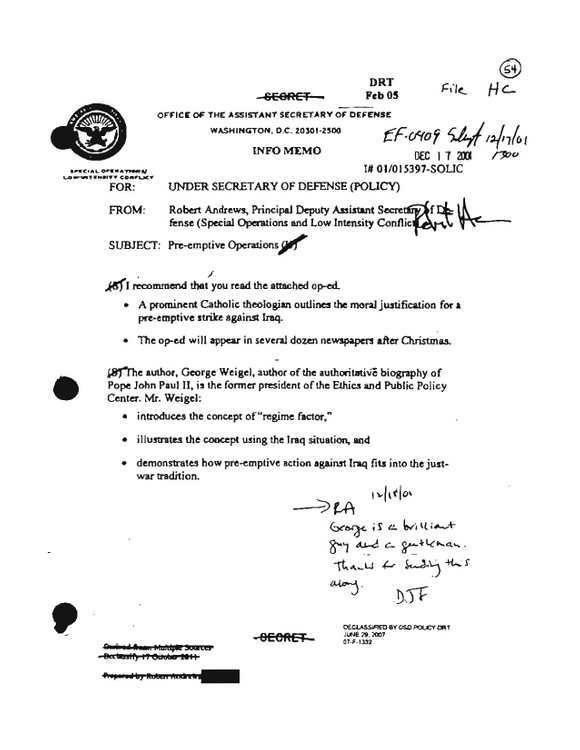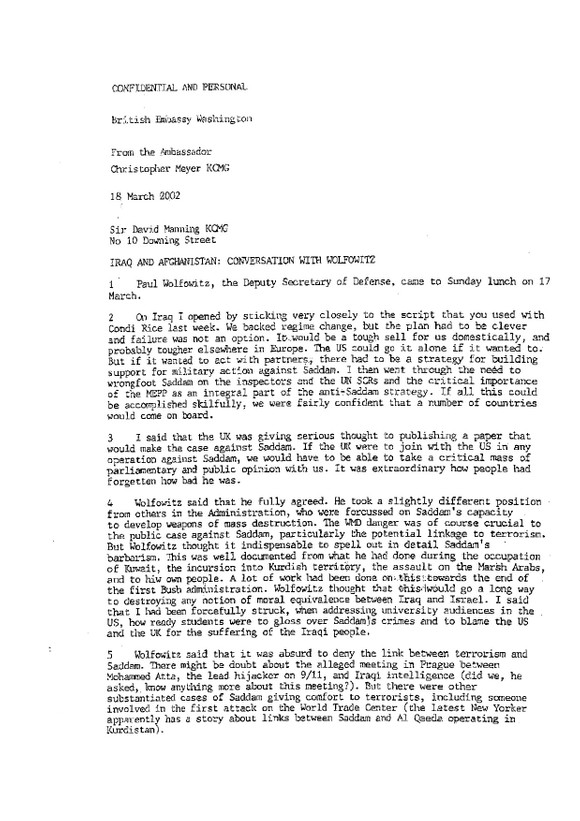Starting from:
$14.95
Home
Foreign Policy
Iraq War 2003: Invasion of Iraq Prelude to War United States and British Documents
Iraq War 2003: Invasion of Iraq Prelude to War United States and British Documents
Iraq War 2003: Invasion of Iraq Prelude to War United States and British Documents
3,128 pages.
A collection of documents highlighting the development of the American and British government's case for going to war against Iraq on March 20, 2003. The documents date from 1997 to 2008, most documents are from the year 2002. They include documents from the Executive Office of the President United States State Department, Department of Defense, Central Intelligence Agency, British Foreign and Commonwealth Office and the British Prime Minister’s Office. The collection also contains American and British Reports reviewing the decisions and intelligence products produced leading p to the war.
Highlights among the documents include:
A memo written three days after George W. Bush was sworn into office, January 23, 2001, U.S. Department of State, Bureau of Near Eastern Affairs Information Memo from Edward S. Walker, Jr. to Colin Powell, titled “Origins of the Iraq Regime Change Policy."
A June 29, 2001 U.S. Department of State Memo from Robert J. Einhorn and James A. Larocco to Colin Powell, “Update on Efforts to Prevent Iraqi Procurement of Aluminum Tubes”
A July 27, 2001 U.S. Defense Department Memo from Donald Rumsfeld to Condoleezza Rice, “Iraq.” Rumsfeld recommends a Principals Committee meeting and then a National Security Council meeting on Iraq, because sanctions are failing, and Iraq’s air defenses seem to be improving. He lists policy options, and says, “Within a few years the U.S. will undoubtedly have to confront a Saddam armed with nuclear weapons” (he also says that Iran will “almost certainly” have nuclear weapons by 2006) and that “If Saddam’s regime were ousted, we would have a much-improved position in the region and elsewhere.”
A December 17, 2001 U.S. Department of Defense Memo from Robert Andrews to Douglas Feith, “Pre-emptive Operations.” The Defense Department’s Special Operations chief advises
Douglas Feith to read a conservative Catholic theologian’s upcoming op-ed asserting a “moral justification for a pre-emptive strike against Iraq” that “demonstrates how pre-emptive action against Iraq fits into the just-war tradition.”
A December 18, 2001 U.S. Department of State Bureau of Intelligence and Research Intelligence Assessment, “Europe: Key Views on Iraqi Threat and Next Steps.” This intelligence assessment indicates that war against Iraq “absent incontrovertible evidence of links to the September 11 attacks” would be highly problematic for France and Germany and that only British Prime Minister Tony Blair, “at substantial political cost,” would support a U.S. attack.
A March 8, 2002 document by the United Kingdom, Cabinet Office, Overseas and Defense. The paper notes, “The US administration has lost faith in containment and is now considering regime change.” The paper reads, “A legal justification for invasion would be needed” and that “none currently exists.” The Cabinet Office analysts recommended a “staged approach” to establish international support, which would anyway be consonant with the requirement for a six-month interval to prepare for military action.
The "Dodgy Dossier." A covering note and draft U.K. white paper: “British Government briefing paper on Iraq - 03 June 2002.” This is the earliest publicly available version of the document that became the U.K. “dossier” on “Iraq’s weapons of mass destruction” published in September 2002. It was described in a covering note as a “consolidated draft of Iraq papers as produced by CIC.” The draft refers obliquely to Iraq’s attempts to acquire: “specialised aluminium [British spelling] which is subject to international export controls because of its potential application in gas centrifuges used to enrich uranium.”
The term "Dodgy Dossier" was first coined by online polemical magazine Spiked in relation to the September Dossier. The term was later employed by Channel 4 News when its reporter, Julian Rush, was made aware of Glen Rangwala's discovery that much of the work in the Iraq Dossier had been plagiarised from various unattributed sources including a 13-year-old thesis produced by a student at California State University. The most notable source was an article by then graduate student Ibrahim al-Marashi, entitled Iraq's Security and Intelligence Network: A Guide and Analysis.
An August 4, 2002 Central Command briefing, “Compartmented Concept Update.” This set of briefing slides presents the overall concept for what would be known to military planners as the “hybrid” war plan, in which war would be launched before forces had reached their full capability, and follow-on increments would supplement the initial attack. The briefing covered such issues as the phases of conflict, ending with a “Phase IV” occupation of Iraq, the time necessary to generate the forces and complete the buildup, and an overview of the military strategy used in the invasion.
A September 11, 2002 U.S. Treasury Department Memorandum Subject: Briefing for your lunch with Vice President Cheney on the economic impact of a war with Iraq. A memo for Treasury Secretary Paul O’Neill from Richard Claudia, Assistant Secretary for Economic Policy.
The final release copy of the "Dodgy Dossier" British Government, dossier on “Iraq’s Weapons of Mass Destruction,” DATE: September 24, 2002. The document that Tony Blair presented to parliament on September 24 made the case, as he put it, for dealing with Iraq’s WMD—and in reality for going to war. Blair’s foreword to the dossier asserted that intelligence had “established beyond doubt” that Saddam Hussein had and was continuing to develop WMD, including weapons that could be launched within 45 minutes. The paper was declared to be based on authentic assessments from within the British intelligence community.
October 4, 2002 CIA white paper, “Iraq’s Weapons of Mass Destruction Programs.” This CIA paper was published two days after the NIE that was being prepared on the same subject. By comparison with the July draft, it had been significantly strengthened. The worst-case nuclear timeline of “within a year” had been added, along with reference to the aluminum tubes.
Each document includes a cover sheet identifying the document, its source and content.
The 2,637 pages of reports include:
House of Commons Foreign Affairs Committee The Decision to go to War in Iraq Ninth Report of Session 2002–03 Volume I Report, together with formal minutes Ordered by The House of Commons to be printed 3 July 2003
House of Commons Foreign Affairs Committee Evidence from Mr. Andrew Gilligan to the Committee's Inquiry into The Decision to go to War in Iraq First Special Report of Session 2002–03 Published on 17 July 2003
Report of the Select Committee on Intelligence on the U.S. Intelligence Community's Prewar Intelligence Assessments on Iraq July 9, 2004 - Phase 1
Comprehensive Report of the Special Advisor to the DCI on Iraq’s WMD, with Addendums (Duelfer Report) Revised April 25, 2005
Senate Report on Iraqi WMD Intelligence Phase II Part 1 Postwar Findings about Iraq's WMD Programs and Links to Terrorism and How they Compare with Prewar Assessments - September 8, 2006
Senate Report on Iraqi WMD Intelligence Phase II Part 2 The Use by the Intelligence Community of Information Provided by the Iraqi National Congress - September 8, 2006
Review of the Pre-Iraqi War Activities of the Office of the Under Secretary of Defense for Policy – Inspector General United States Department of Defense – February 9, 2007
Senate Report on Iraqi WMD Intelligence Phase II Part 3 Prewar Intelligence Assessments About Postwar Iraq - May 25, 2007
Senate Report on Intelligence Activities Relating to Iraq conducted by the Policy Counterterrorism Evaluation Group and the Office of Special Plans within the Office of the Under Secretary of Defense for Policy. June 2008
This collection can also be found in the collection George W. Bush Presidential Papers - George W. Bush Administration Papers & Reports . That collection includes other sections covering the Iraq War.




3,128 pages.
A collection of documents highlighting the development of the American and British government's case for going to war against Iraq on March 20, 2003. The documents date from 1997 to 2008, most documents are from the year 2002. They include documents from the Executive Office of the President United States State Department, Department of Defense, Central Intelligence Agency, British Foreign and Commonwealth Office and the British Prime Minister’s Office. The collection also contains American and British Reports reviewing the decisions and intelligence products produced leading p to the war.
Highlights among the documents include:
A memo written three days after George W. Bush was sworn into office, January 23, 2001, U.S. Department of State, Bureau of Near Eastern Affairs Information Memo from Edward S. Walker, Jr. to Colin Powell, titled “Origins of the Iraq Regime Change Policy."
A June 29, 2001 U.S. Department of State Memo from Robert J. Einhorn and James A. Larocco to Colin Powell, “Update on Efforts to Prevent Iraqi Procurement of Aluminum Tubes”
A July 27, 2001 U.S. Defense Department Memo from Donald Rumsfeld to Condoleezza Rice, “Iraq.” Rumsfeld recommends a Principals Committee meeting and then a National Security Council meeting on Iraq, because sanctions are failing, and Iraq’s air defenses seem to be improving. He lists policy options, and says, “Within a few years the U.S. will undoubtedly have to confront a Saddam armed with nuclear weapons” (he also says that Iran will “almost certainly” have nuclear weapons by 2006) and that “If Saddam’s regime were ousted, we would have a much-improved position in the region and elsewhere.”
A December 17, 2001 U.S. Department of Defense Memo from Robert Andrews to Douglas Feith, “Pre-emptive Operations.” The Defense Department’s Special Operations chief advises
Douglas Feith to read a conservative Catholic theologian’s upcoming op-ed asserting a “moral justification for a pre-emptive strike against Iraq” that “demonstrates how pre-emptive action against Iraq fits into the just-war tradition.”
A December 18, 2001 U.S. Department of State Bureau of Intelligence and Research Intelligence Assessment, “Europe: Key Views on Iraqi Threat and Next Steps.” This intelligence assessment indicates that war against Iraq “absent incontrovertible evidence of links to the September 11 attacks” would be highly problematic for France and Germany and that only British Prime Minister Tony Blair, “at substantial political cost,” would support a U.S. attack.
A March 8, 2002 document by the United Kingdom, Cabinet Office, Overseas and Defense. The paper notes, “The US administration has lost faith in containment and is now considering regime change.” The paper reads, “A legal justification for invasion would be needed” and that “none currently exists.” The Cabinet Office analysts recommended a “staged approach” to establish international support, which would anyway be consonant with the requirement for a six-month interval to prepare for military action.
The "Dodgy Dossier." A covering note and draft U.K. white paper: “British Government briefing paper on Iraq - 03 June 2002.” This is the earliest publicly available version of the document that became the U.K. “dossier” on “Iraq’s weapons of mass destruction” published in September 2002. It was described in a covering note as a “consolidated draft of Iraq papers as produced by CIC.” The draft refers obliquely to Iraq’s attempts to acquire: “specialised aluminium [British spelling] which is subject to international export controls because of its potential application in gas centrifuges used to enrich uranium.”
The term "Dodgy Dossier" was first coined by online polemical magazine Spiked in relation to the September Dossier. The term was later employed by Channel 4 News when its reporter, Julian Rush, was made aware of Glen Rangwala's discovery that much of the work in the Iraq Dossier had been plagiarised from various unattributed sources including a 13-year-old thesis produced by a student at California State University. The most notable source was an article by then graduate student Ibrahim al-Marashi, entitled Iraq's Security and Intelligence Network: A Guide and Analysis.
An August 4, 2002 Central Command briefing, “Compartmented Concept Update.” This set of briefing slides presents the overall concept for what would be known to military planners as the “hybrid” war plan, in which war would be launched before forces had reached their full capability, and follow-on increments would supplement the initial attack. The briefing covered such issues as the phases of conflict, ending with a “Phase IV” occupation of Iraq, the time necessary to generate the forces and complete the buildup, and an overview of the military strategy used in the invasion.
A September 11, 2002 U.S. Treasury Department Memorandum Subject: Briefing for your lunch with Vice President Cheney on the economic impact of a war with Iraq. A memo for Treasury Secretary Paul O’Neill from Richard Claudia, Assistant Secretary for Economic Policy.
The final release copy of the "Dodgy Dossier" British Government, dossier on “Iraq’s Weapons of Mass Destruction,” DATE: September 24, 2002. The document that Tony Blair presented to parliament on September 24 made the case, as he put it, for dealing with Iraq’s WMD—and in reality for going to war. Blair’s foreword to the dossier asserted that intelligence had “established beyond doubt” that Saddam Hussein had and was continuing to develop WMD, including weapons that could be launched within 45 minutes. The paper was declared to be based on authentic assessments from within the British intelligence community.
October 4, 2002 CIA white paper, “Iraq’s Weapons of Mass Destruction Programs.” This CIA paper was published two days after the NIE that was being prepared on the same subject. By comparison with the July draft, it had been significantly strengthened. The worst-case nuclear timeline of “within a year” had been added, along with reference to the aluminum tubes.
Each document includes a cover sheet identifying the document, its source and content.
The 2,637 pages of reports include:
House of Commons Foreign Affairs Committee The Decision to go to War in Iraq Ninth Report of Session 2002–03 Volume I Report, together with formal minutes Ordered by The House of Commons to be printed 3 July 2003
House of Commons Foreign Affairs Committee Evidence from Mr. Andrew Gilligan to the Committee's Inquiry into The Decision to go to War in Iraq First Special Report of Session 2002–03 Published on 17 July 2003
Report of the Select Committee on Intelligence on the U.S. Intelligence Community's Prewar Intelligence Assessments on Iraq July 9, 2004 - Phase 1
Comprehensive Report of the Special Advisor to the DCI on Iraq’s WMD, with Addendums (Duelfer Report) Revised April 25, 2005
Senate Report on Iraqi WMD Intelligence Phase II Part 1 Postwar Findings about Iraq's WMD Programs and Links to Terrorism and How they Compare with Prewar Assessments - September 8, 2006
Senate Report on Iraqi WMD Intelligence Phase II Part 2 The Use by the Intelligence Community of Information Provided by the Iraqi National Congress - September 8, 2006
Review of the Pre-Iraqi War Activities of the Office of the Under Secretary of Defense for Policy – Inspector General United States Department of Defense – February 9, 2007
Senate Report on Iraqi WMD Intelligence Phase II Part 3 Prewar Intelligence Assessments About Postwar Iraq - May 25, 2007
Senate Report on Intelligence Activities Relating to Iraq conducted by the Policy Counterterrorism Evaluation Group and the Office of Special Plans within the Office of the Under Secretary of Defense for Policy. June 2008
This collection can also be found in the collection George W. Bush Presidential Papers - George W. Bush Administration Papers & Reports . That collection includes other sections covering the Iraq War.




1 file (71.5MB)



